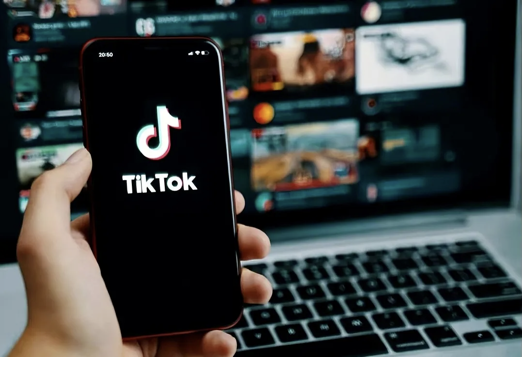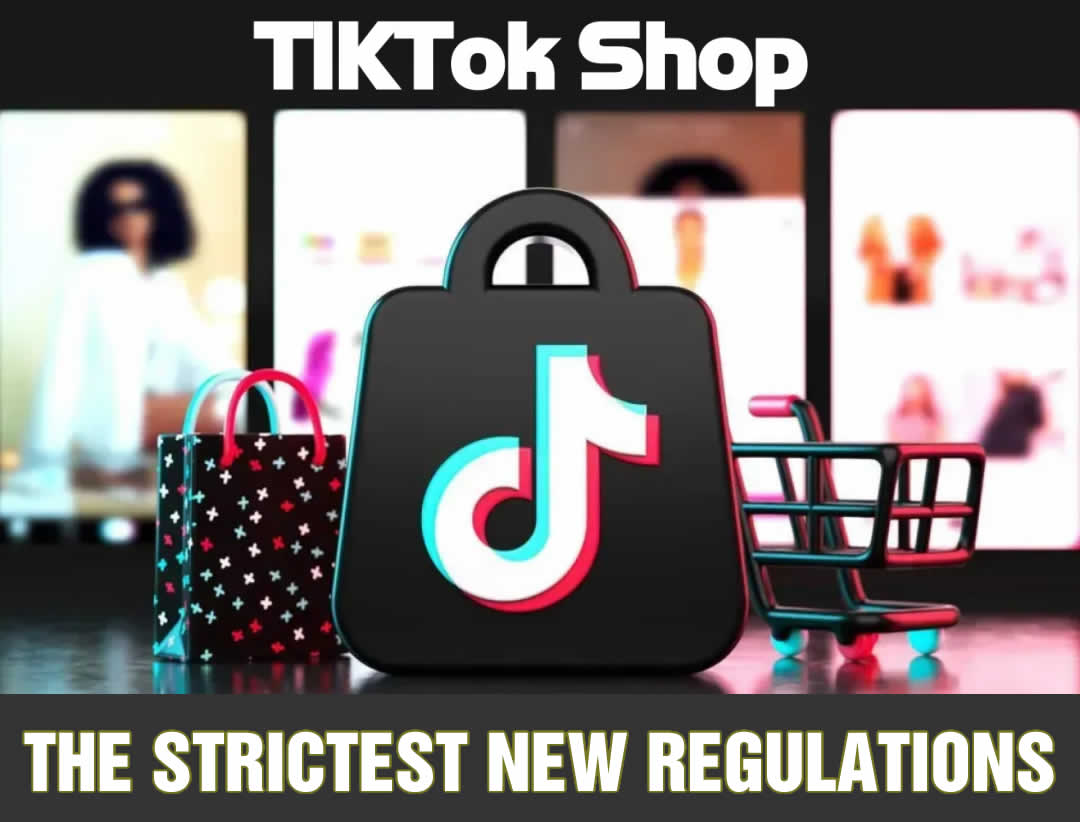As the number of apps increases and user expectations rise, apps that cannot quickly meet user needs are swiftly abandoned. It is evident that an app being uninstalled is often a sign of user dissatisfaction and should not be ignored. This is especially critical for freemium apps that rely on continuous user engagement to generate profit. Understanding the motives, timing, and context of user uninstalls is crucial.
Half of Android apps are uninstalled within 30 days – dating apps > 60%, travel and news apps < 30%
- Non-gaming apps perform the worst at around 24%
- Nearly half of the uninstalls occur on the first day, and 80% happen within a week
Reasons for User Uninstallation
- Overabundance of Apps: Users are faced with an overwhelming number of apps, leading to more varied choices.
- Gap Between Promises and Experience: Discrepancies between app advertisements and the actual experience cause user disappointment.
- Impulsive Installs: Particularly in the gaming sector, users are easily tempted to install apps impulsively and then quickly uninstall them.
- Storage Space Limitations: As media content becomes richer, limited storage space prompts users to delete apps.
- Privacy Concerns: Worries about data privacy make users hesitant to share sensitive information.
Impact of Uninstall Rates
The rise in uninstall rates directly increases the cost of user retention. Given the high costs of user acquisition, a high uninstall rate renders strategies based solely on purchasing user downloads ineffective. Consequently, advertisers are shifting towards event-based purchase strategies, focusing more on user behavior and engagement rather than just download numbers.
Uninstall Rates in 2023
The uninstall rate improved by 10% in 2023 compared to the previous year, indicating some level of improvement, but the issue remains severe. Data shows that for every two app installations, more than one is uninstalled within 30 days. This phenomenon is particularly pronounced in dating and gaming apps, where over half of the games are uninstalled within 30 days. Additionally, uninstall rates are generally higher in developing countries compared to developed countries, with an average gap of around 20%.
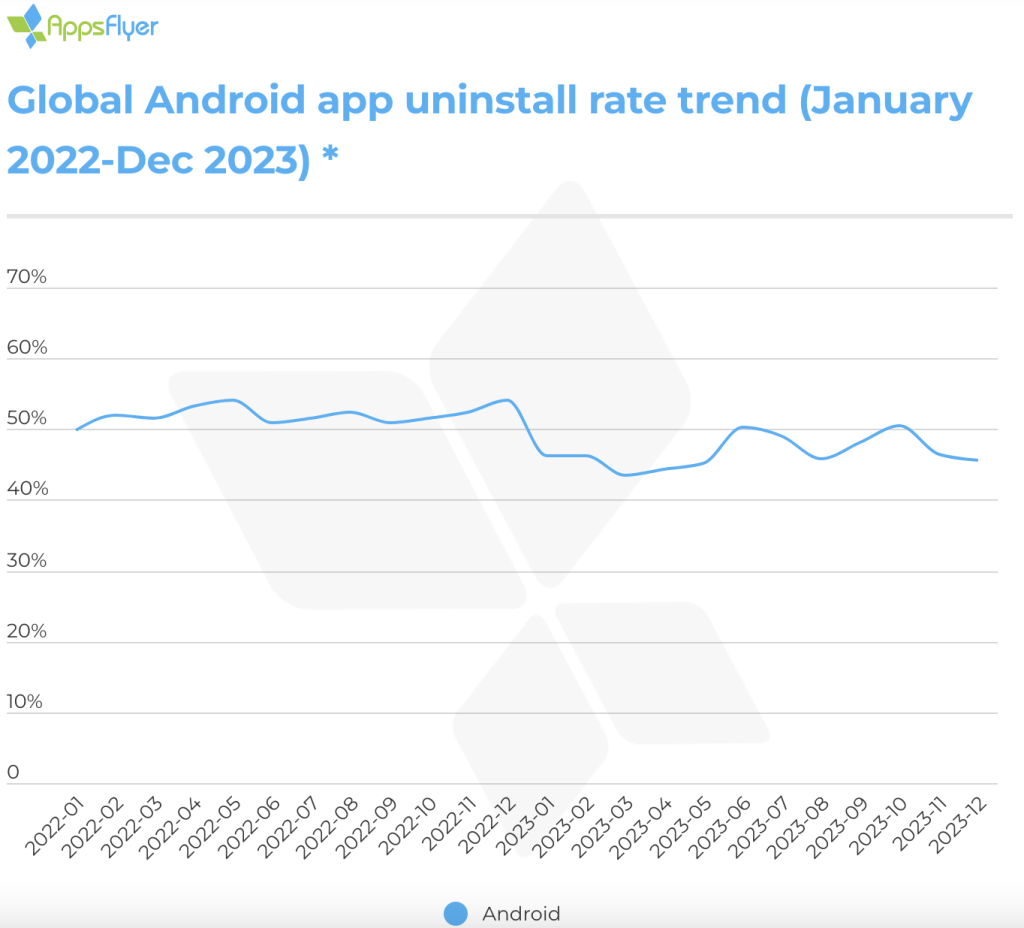
Explanation
- Within 30 Days Post-Installation: These figures represent the average for each app.
- Android Data Only: iOS uninstallation tracking has been limited since iOS 15.
It is clear that users have very low tolerance for apps that fail to meet expectations, especially given the numerous alternatives for almost every app. Although uninstallation remains a significant pain point for apps, the fact that uninstall rates have improved (10% year-over-year increase in 2023; 8% increase in 2022) is a positive trend. This improvement is likely related to advertisers shifting from simply buying downloads to event-based purchasing strategies.
Dating and gaming apps are the most affected by uninstall rates.
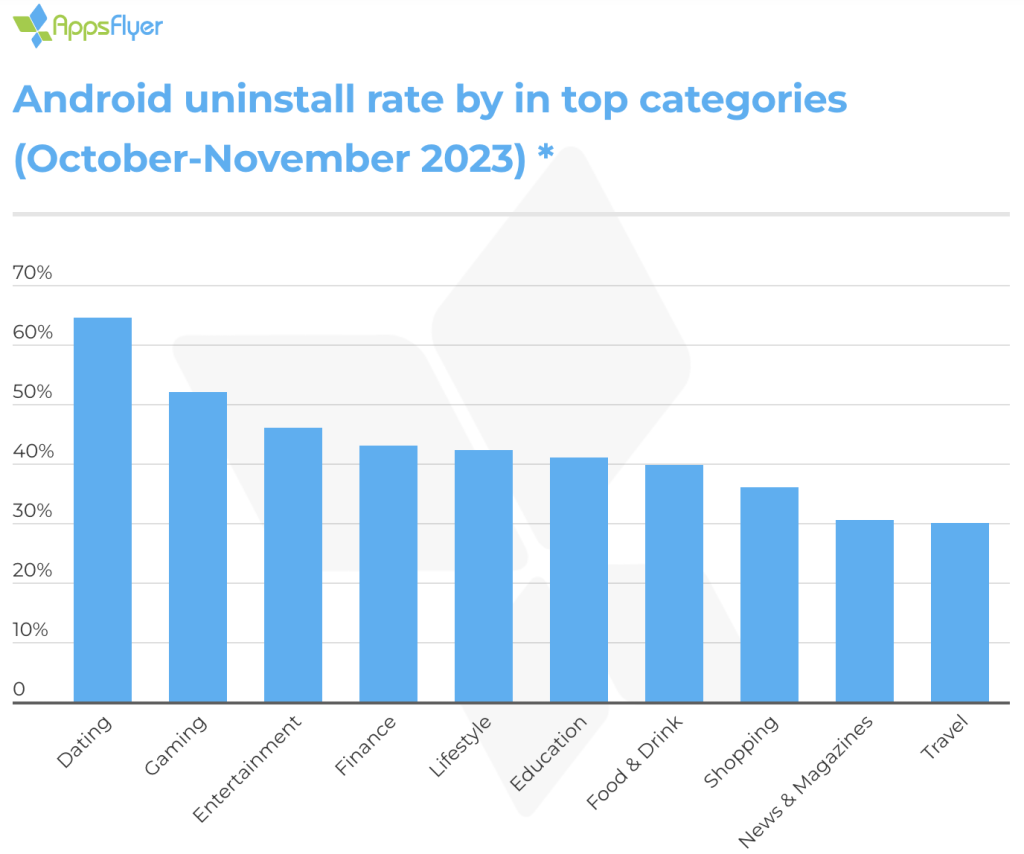
Dating apps have the highest uninstall rates, followed by gaming and entertainment apps. In fact, more than half of gaming apps are uninstalled within 30 days. This is due to the exploratory nature of gaming, as users continuously try new games. If a game does not make a memorable first impression, it is often uninstalled in the blink of an eye.
Additionally, when storage space becomes an issue, users are more likely to uninstall games rather than delete other data. In contrast, brands significantly help shopping, finance, or other lifestyle-related apps. Brands in these categories are usually well-known to users outside of the app, making their connections stronger.
On the other hand, the high 30-day uninstall rate for dating apps might be due to users’ lack of patience or because, in the post-COVID era, people are returning to old habits—face-to-face interactions.
The natural/unnatural gap in the gaming sector is only 14%.
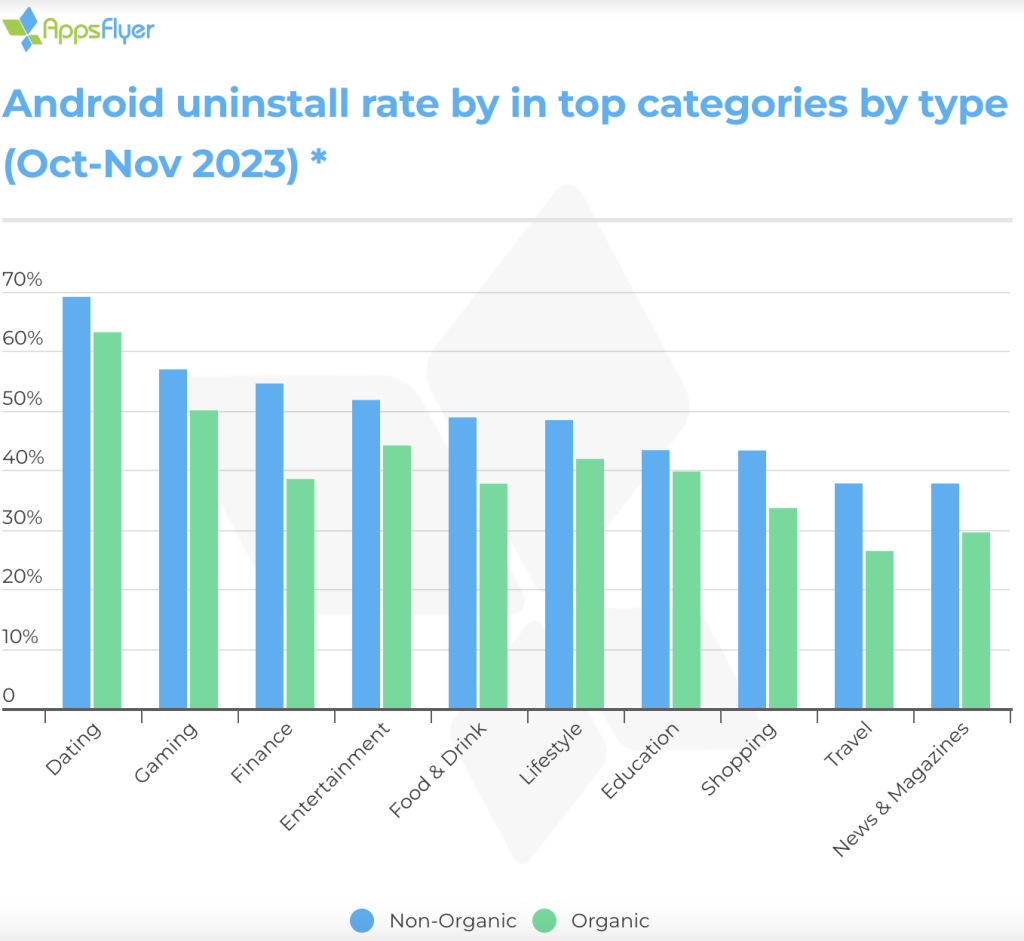
Natural users have higher intent compared to non-natural users, so it is not surprising that their uninstall rates are much lower—the average difference between categories is 24%.
There is a significant gap between dating apps and other categories, with non-natural users having an uninstall rate of 69% by the 30th day. This can be attributed not only to the abundance of dating apps but also to users’ impatience and lack of experience with dating apps.
Although gaming apps rank second, the gap between the 30-day natural and non-natural uninstall rates is smaller compared to non-gaming apps. In gaming apps, this gap is only 14%, while in non-gaming apps, it hovers around 25%.
This observation can be attributed to the exploratory behavior typically associated with games. Users often try new games directly from the app store, leading to a smaller gap between natural and non-natural uninstall rates within the gaming category.
Uninstall Rates in Developing vs. Developed Countries
The uninstall rate in developing countries is 20% higher than in developed countries. The uninstall rate in developing countries (such as Peru with 18% and Pakistan with 30%) is significantly higher compared to the average uninstall rate of 51% in developed countries like the USA, UK, Japan, South Korea, France, and Germany. Developing markets like Nepal, Bangladesh, and Pakistan have the highest uninstall rates. Overall, the average gap is 20%.
Even developed countries are not immune to high uninstall rates. The primary reasons for this gap are the predominant use of iOS operating systems and high-storage device types in these regions.
Strategies to Address High Uninstall Rates
When facing the challenge of high uninstall rates, developers and marketers need to adopt a comprehensive approach. From enhancing user experience to optimizing marketing strategies, every aspect is crucial. Implementing more refined user acquisition and engagement strategies can effectively increase user retention, leading to success in a competitive market. The following points are essential:
- Measure Uninstall Rates: Understanding the reasons, timing, and sources of uninstalls is crucial for reducing them.
- Optimize First Impressions: High uninstall rates often occur on the first day. Ensuring a seamless and engaging initial experience is vital to establishing a strong and lasting connection with users.
- Fulfill Promises: Avoid over-promising and ensure that the app meets user expectations.
- Transparent Communication: Effectively introduce your app to users using video ads, relevant playable ads, and highly descriptive app store pages with videos and images. The more users know about your app, the less likely they are to uninstall it.
- Maintain Engagement: Encourage continuous user engagement and keep the app visible through various channels such as push notifications, emails, retargeting, and social media. Ensure the best user experience by avoiding overexposure, carefully scheduling re-engagement efforts, and implementing deep links to facilitate a seamless user journey.
- Actively Respond to Feedback: Engage with and address user issues on social media and in app store reviews.
- Prioritize Privacy and Security: Ensure user data is secure and offer privacy protection through uninstall measurement.
- Define Internal KPIs: Understand user interaction and app performance by tracking in-app events and user behavior.
- Create an Excellent App: Ultimately, the key to reducing uninstall rates is to develop a high-quality app that meets user needs.
Additionally, measuring the uninstall rate and understanding the reasons, timing, and sources behind it are extremely important. Implementing uninstall attribution can effectively reduce user churn. Optimizing the onboarding experience, avoiding over-promising, and using video ads and descriptive app store pages can help users better understand the app, thus reducing the likelihood of uninstallation.
In conclusion, despite the many challenges faced by app developers, there are opportunities to reduce uninstall rates and increase user retention through comprehensive strategies and continuous optimization. Understanding user needs, providing a high-quality app experience, and maintaining good communication with users through various channels are key to improving user retention and app success.

